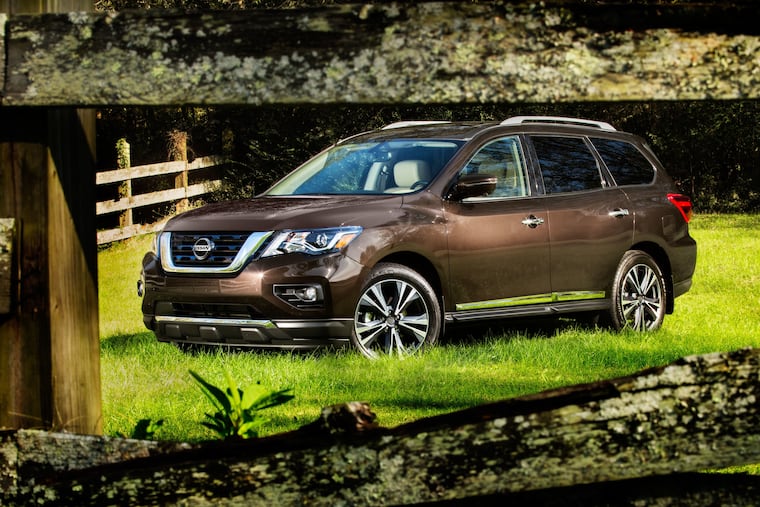Nissan Pathfinder remains a solid value, but that’s about it
In a comparison on SUVs that aim to be more heavy duty, the 2019 Nissan Pathfinder offers intelligent four-wheel drive, three rows, and good value. But it isn't enough to beat the new Honda Passport.

2019 Honda Passport Elite AWD vs. 2019 Nissan Pathfinder Rock Creek Edition: A little bit country.
This week: Nissan Pathfinder.
Price: $44,455 as tested.
Conventional wisdom: Car and Driver likes the “solid value in this class, cushy cabin experience, notable 6,000-pound towing capacity,” but not that it “drives more boat-like than it should, middling cargo storage, small third row.”
Marketer’s pitch: “Adventure, advanced.”
Reality: I’d settle for better on-road handling.
What’s new: The Rock Creek Edition is the big news of the model year. For 2020, not much will change.
Nissan writes: “The Rock Creek Edition name was chosen to connect the vehicle to Pathfinder's family outdoor adventure-minded target customers. The Rock Creek Edition name also connects to Pathfinder's proud rugged heritage.”
I never put the Pathfinder to a toughness test, but people looking for the real thing will have found it. The model’s intelligent four-wheel drive does offer a 4WD lock mode, as well as automatic and two-wheel drive modes. The SUV also tows up to 6,000 pounds, and the Rock Creek comes with a trailer hitch as standard. So it’s a step above the Passport in that regard.
On the road: With Nissan’s takeover of Renault — stymied by the French government — fresh in my mind as I drove, I kept going back to one of my favorite French phrases: rabat-joie, translated literally for me as “joy-stealer,” but more like a spoilsport.
The Pathfinder in France would best be called the Rabat-Joie. (It’s actually the X-Trail.) Well, Mr. Driver’s Seat will send them the idea and wait excitedly by the phone.
Not only does it make traveling on twisting roads joyless and uninspiring, the Pathfinder even makes highways difficult. I’d never had to correct the steering so many times on a trip to Western Pennsylvania.
I expected the shorter Pathfinder to be a breeze to drive, but no.
Up to speed: The acceleration initially left me kind of pleased. Although Motor Trend said the Pathfinder’s 284-horsepower 3.5-liter V-6 takes a long 7.4 seconds to get to 60 mph, I thought it rolled onto highways without much trouble.
Spending more time with the Pathfinder left me disappointed. First, getting from 70 to 105 is far too easy — far easier than useful levels of acceleration, like for getting from 45 to 70. Yes, I found this out quite by accident.
Second, passing on steep hills is severely disappointing. While traveling a familiar mountain road in Western Pennsylvania, I found its ability to go from 30 to 60 uphill frighteningly inadequate. This is a move I’ve made on this particular road many times, so I know how it should feel.
Shiftless: Much of the blame rests with the Pathfinder’s CVT. No paddle shifters or stick shift allowed me to set the rpms. The available low setting may have helped, but I didn’t want to risk crunching the transmission so far from home.
Driver’s Seat: I found the accommodations fairly comfy. Nissan has worked out some rather nice leather seats that don’t leave one fatigued even on long trips. And the dashboard is fairly easy to read.
Friends and stuff: The rear two rows are surprisingly not bad. The middle row moves forward and back, which helps immensely. The leg room feels quite like economy class, but I’ve been in tighter (I’m looking at you, Mitsubishi Outlander). Head room is snug, and the rear seat sits very low. Foot room in back is poor and in the middle is, well, middling. (Of course, the Passport offers only two rows, so advantage Pathfinder.)
Play some tunes: Nissan clings to the old multi-button controls for its infotainment systems, and the result remains cumbersome at best. A dial in the center allows operators to twist around the touchscreen, but then a bevy of close to 20 buttons controls most functions. Knobs controlling volume and tuning certainly help a lot.
Navigating the system was not so difficult, but as in most Nissans, sound from the unit was a B-plus at best. If I wanted to get the treble right, it was too bassy, and vice versa. Advantage Passport.
Keeping warm and cool: Here, the cacophony of buttons becomes a bit of a struggle, as does the fact that they sit way down by the console.
Dials control heat for either side and a center dial controls fan speed. But the system control seems to follow its own moody guidelines to cooling unless you press “auto”; that was the only way to cool things down on a hot day.
Night shift: We began the return from our Labor Day adventure at 8:45 p.m., so plenty of time to test out the night qualities. The headlights illuminate the road nicely, while the interior lights run a little on the dim side.
Fuel economy: I averaged about 21 mpg in a lot of highway driving across Pennsylvania.
Where it’s built: Smyrna, Tenn.
How it’s built: Consumer Reports gives the Pathfinder a 3 out of 5 for predicted reliability. Advantage Pathfinder.
In the end: This may be a more off-roady Pathfinder, but I’d like something that does roads better. Given a choice between the two, I’d have to pick the Passport, and given more leeway, I’d probably go for the Pilot or a Kia Telluride.